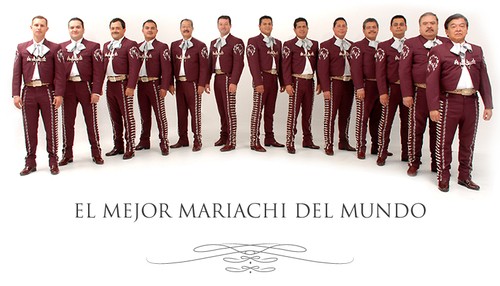
Hate to break it to you, folks, but this weekend, the Valentine's Day fanfare will already be in full swing: the overpriced dinner for two, the crowded greeting-card aisle at the pharmacy, the cross-eyed stuffed animal/synthetic roses-wrapped-in-cellophane stand on the gas-station parking lot, etc. Valentine's Day is an easy target; it's so trendy to hate love.
]
But get over it because love is here to stay. Even the Starbucks cups this month remind us to “celebrate everylove.” So you have two choices: bitterly hibernate for the next couple of days, or face the music and take in all the love.
Speaking of music, what better way to tap into the greatest emotion mankind has to experience (yes, love) than through a genre that UNESCO recently added to its list of intangible cultural patrimony: mariachi. You've seen this force in action, be it through a Robert Rodriguez cult classic, a Sesame Street episode, or the YouTube video of Lady Gaga serenading herself on her birthday with a mariachi version of “Born This Way.”
But to really understand mariachi–and its evolution over more than a century–you need to go back to the godfather of the genre: Mariachi Vargas de Tecalitlán. Their history can be dated back to the end of the 17th century, and they've held such honors as being the first to incorporate the charro suit as the genre standard, being hired by Mexican president Lázaro Cardenas in 1934 as the official mariachi of the Mexico City Police Department, appearing in more than 200 films with Mexican music legends including José Alfredo Jimenez, and appearing with Linda Ronstadt on her Grammy-winning album Canciones De Mi Padre.
We recently asked Mariachi Vargas de Tecalitlán about their upcoming projects, their Facebook friends, and the enternal mystery of whether real macho men cry. Here's what they had to say:
OC Weekly: A quick mariachi search on YouTube will reveal mariachis covering songs ranging from “Sweet Home Alabama” to “Hotel California” and even reggae god Bob Marley's “No Woman No Cry.” What is Mariachi Vargas de Tecalitlán doing to evolve with the times?
Mariachi Vargas de Tecalitlán: We're constantly working on new, original material. Our musical director, Pepe Martinez, has been working on the first mariachi opera, which will debut in 2013. We definitely can appreciate what other musical groups are doing with the covers, but we feel most committed to the classics, paying homage to the tradition and genre. The fans have come to expect it of us, and year after year, we sell out.
A couple of months ago, UNESCO proclaimed mariachi as a cultural patrimony of the world? Given your worldwide tours, do you feel you contributed to this recognition?
We feel incredibly honored and satisfied to be part of something so culturally significant. We have always made every effort to be proud representatives of the genre when we travel around the world. We've played to enthusiastic crowds everywhere from France to Japan to Germany to Puerto Rico.
What does the genre of mariachi bring, emotionally, that other genres do not?
Mariachi is integral to life's events–baptisms, quinceañeras, weddings, even funerals. It taps into man's raw, naked, powerful, hidden emotions; mariachi songs will take you back to your first love and to your first heartbreak. At our concerts, one minute, you can be in your seat, crying as you mourn a lost love–with a beer in hand, of course–while listening to “Me Canse de Rogarle,” and another minute, you'll be out of your seat, dancing to “Mariachi Loco,” reminded of a joyous occasion. The strings in mariachi are symphonic in nature and always tell a story.
So it's okay for macho men to cry?
Of course, but even more so while listening to mariachi.
I see you're dabbling in social media. You have nearly 5,000 friends on Facebook–by the way, I'm still waiting for you to accept my request!–and more than 6,000 “likes” on your fan page. Can we expect you to start tweeting soon, or create your own YouTube channel?
Sorry about your friend request; we'll work on that immediately! Truthfully, we realize we need to do more to stay connected with our fans through social media, and we realize we're underserving this market. But we're working on it.
Did you know that Harvard University has its own mariachi, Mariachi Véritas de Harvard, as does UCLA, with its Mariachi UCLAtlán, and Stanford, with Mariachi Cardenal de Stanford? How do you feel about having such prestigious universities embrace the genre, with students of all ethnicities participating? What are you doing to pass the torch to future generations?
That's incredible to hear. Well, we're constantly telling the young guys, “Okay, you're the next generation of musicians; you need to make sure the tradition doesn't die away. We need to make sure we reach out to the next generation of musicians and fans.” Every city we perform in, we try to get a local mariachi youth group to open for us, or we at least try to hold a workshop. For our show in Anaheim, we're helping a group from UC Riverside raise funds, and we made tickets available for another group from South Orange County.
What can fans expect from Saturday's show?
The reason we chose the [City National Grove of Anaheim] is because it's the type of venue that allows us to maximize our production, all the while still maintaining an intimate setting. Expect an amazing production, with lighting and staging to enhance our deep repertoire of songs; you'll hear the classics, but always in the unique Vargas way.
Mariachi Vargas de Tecalitlán perform at the City National Grove of Anaheim, 2200 E. Katella Ave., Anaheim, (714) 712-2700; www.thegroveofanaheim.com. Sat., Feb. 11, 8 p.m. $43 and up.

